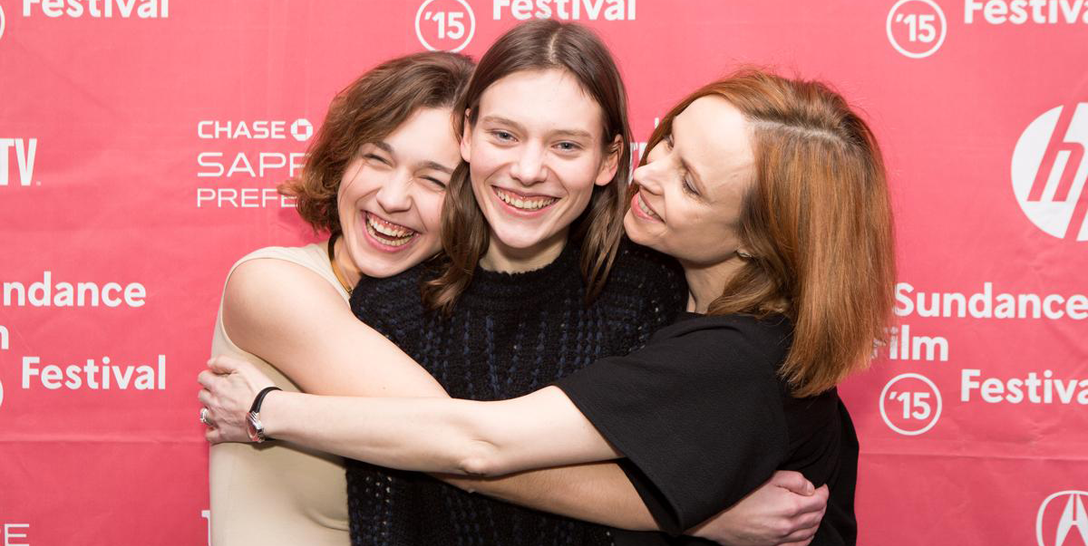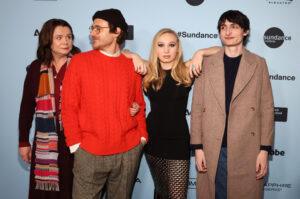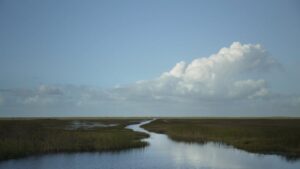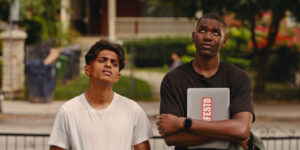Day One’s premiere screening of ‘The Summer of Sangaile.’ © Sundance Institute | Ryan Kobane
Sundance Institute
Sundance.org is dispatching its writers to daily screenings and events to capture the 10 days of festivities during the Sundance Film Festival in Park City, Utah. Check back each morning for roundups from the previous day’s events.
The Bronze
by Jeremy Kinser
While introducing The Bronze, a deeply raunchy and often boisterously funny comedy that opened the 2015 Sundance Film Festival at Eccles Theater, Festival Director John Cooper informed the audience that there have been very few times when he’s only three-quarters through watching a film and becomes convinced the film will make the lineup, regardless of what his staff thinks. “My staff didn’t argue this time,” he added.
Prior to the screening, Cooper brought the film’s director, Bryan Buckley, whose short film Asad was Oscar-nominated in 2013, on stage to introduce the cast. Before he called up his leading lady, The Big Bang Theory’s Melissa Rauch, he described her to the audience as “the woman you will hate in the first five minutes of this film.”
There wasn’t much dispute from the audience here, either. If the crowd didn’t actually hate Hope Ann Greggory, Rauch’s past-her-prime Olympic Bronze medal-winning gymnast, they were for the most part hilariously horrified by the despicable behavior of her character.
©Sundance Institute | Stephen Speckman
We first encounter the now washed-up Hope Ann living in small Amherst, Ohio, masturbating to VHS footage of her Olympic glory days, stealing money from the mailbag of her postman father (Gary Cole), snorting allergy medicine, and generally making life as miserable as possible for everyone in her orbit. She’s an even more crass version of Tonya Harding by way of South Park’s Cartman with perhaps some of the scheming of Election’s Tracy Flick tossed in for good measure.
Yet, following the death of her former instructor, Hope Ann gets a shot at redemption when tricked into training another local gymnast (Haley Lu Richardson) with a chance at Olympic glory, as well as a possible romance with the shy, sweet manager of the gym (Thomas Middleditch), who she deems “Twitchy” due to a few nervous tics.
Many of the questions from the audience focused on an outrageously-staged sex scene that featured cartwheels, pirouettes and pole vaults. Buckley asked the audience to stick around as there’d be an audition for a similar sex scene in the film’s sequel, while Rauch, who co-wrote the screenplay with husband Winston Rauch, said, “As for the sex scene, you write what you know.”
Rauch said she and her husband were inspired to write the comedy because they’ve always been fascinated by the bronze medal and how it’s become an international symbol for mediocrity and how that affects the winner. “Basically the whole world forgets about it except for the small town you live in,” she said. “The idea of celebrity in a small town just really fascinated us.”
The Summer of Sangaile
by Eric Hynes
The 2015 Sundance Film Festival was off to a flying start with The Summer of Sangaile, a coming of age story about a young woman who channels her anxieties and insecurities into dreams of joining a death-defying aerial show. While young Sangaile is in danger of retreating entirely into a state of quietly coping, she’s guided into enjoying life and conquering her fears – and opening up sexually – by a beautiful eccentric named Auste.
As programmer Trevor Groth said before the screening, The Summer of Sangaile is the first Lithuanian film to ever play at the Festival. Though director Alanté Kavaïté now splits her time between France and Lithuania, she said in the post-screening Q&A that is was essential to set this particular story of emerging womanhood in the land where she was born and raised. And while the film’s fixation on stunt piloting may seem like a charming quirk to American audiences, she noted that it’s actually a common strain of Lithuanian culture.
“Lithuanians have an obsessive relationship with planes and flying,” she said. “I spent a lot of time at air shows as a child. When I started thinking about my adolescence I realized it was a perfect metaphor for my character – someone fighting to become herself. To be a pilot you have to have so much strength.” And though there are some autobiographical elements to the story, Kavaïté said that there’s a deeper sense of belonging at play. “There’s some of me in the film,” she said, “but a lot of Lithuania.”

During some of the more intense scenes during the world premiere screening, young actresses Julija Steponaityté and Aisté Dirziüté – both making their acting debuts – could be seen supportively holding hands. Afterwards, Kavaïté discussed the scenes in which Steponaityté not only had to fly in a somersaulting stunt plane, but because of the small cockpit actually had to film herself. It’s only safe to fly in those planes for 11 minutes because of the G Forces, and so Steponaityté had to get footage for two different scenes, one unhappy and one happy, as Kavaïté said. “At first it was hard, but on the third day I felt wonderful,” the actress said. In fact she found it far more difficult to shoot the film’s sex scenes – a far different fear of flying.
What Happened, Miss Simone?
by Jeremy Kinser
Taking its title from a Maya Angelou quote, the riveting documentary What Happened, Miss Simone? uncovers the complicated true story of Nina Simone, a remarkably gifted, but deeply troubled and often exasperating woman, who had found her voice in music and became an iconic figure to many Americans struggling for civil rights during the turbulent 1960s. The opening night film screened out of competition and will premiere on Netflix this spring.
Director Liz Garbus, a Sundance vet with previous docs The Farm: Angola USA and Bobby Fischer Against the World, has exceptionally rich material with Simone. Born into a religious family in North Carolina, Simone was a child prodigy whose plan to become a classic pianist was thwarted because she was black.
Garbus incorporates a rich archive of rare footage of Simone in concert (including a sublime performance of “Mississippi Goddam”) and photos with other iconic figures of the civil rights era, recently unearthed audiotapes, diaries, letters and interviews with Simone’s daughter Lisa Simone Kelly and many of the late entertainer’s close friends and collaborators into a portrait of a mercurial woman. Garbus lets the audience see that it was as much Simone’s “demons,” as they’re often referred to – including a lengthy battle with manic depression that led to estrangement with her daughter – as well as her political awakening that sometimes prevented her from achieving the crossover success of peers like Aretha Franklin. After living as an ex-pat in Africa, Simone moved around Europe, battled breast cancer in addition to mental illness, but continued to tour the world until her death in 2003.
Following the film, festival director John Cooper brought Garbus to the stage and asked her why it was important to share Simone’s story now.
After a long pause, Garbus told the audience: “If we had voices like Nina Simone today speaking the pain and the passion of the movement that’s been building on the streets during the past six months… Nina said in one of her late interviews, ‘There is no civil rights movement and there is no place for those songs.’ I think that’s one of the saddest moments for me in the film because we can see the place for these songs. I ask the artists today to appropriate those songs and to continue them and let the music mean something again.”

the premiere of ‘What Happened,
Miss Simone?’ ©Jason Merritt/Getty
It was an ideal way to segue into the special concert performance by Grammy Award-winning recording artist John Legend. Garbus described the performer as “having quite a month,” referring to his recent Golden Globe win and Academy Award nomination for “Glory,” the theme from the civil rights drama Selma.
Seated at an enormous black piano. Legend performed three songs, including a rendition of ones of Simone’s signature tunes “Please Don’t Let Me Be Misunderstood” in which his usual smooth voice became a plaintive wail and drew sustained applause.
How to Change the World
by Eric Hynes
As Bob Hunter, a founder and reluctant leader of Greenpeace, says in this chronicle of the organization’s dramatic rise from a band of scruffy idealistic daredevils to a worldwide environmentalist movement: “It’s about putting on a good show.” Judging from the scene at the MARC Theater on Thursday, the Opening Night of the 2015 Sundance Film Festival, director Jerry Rothwell certainly succeeded in that department.
Working from 1,500 silver cans of 16mm film, as well as two suitcases full of 150 quarter inch reel-to-reels found in the Greenpeace archives in Amsterdam, Rothwell crafts a narrative that begins with Hunter leading an oceanic expedition to subvert nuclear testing in 1971, through the organization’s first whale and seal campaigns, and ends in 1979 when internal fighting led the founding members to create Greenpeace International. Throughout, interviews with surviving members of the movement provide context for and counterpoints to the footage, while Hunter’s own words (he died in 2005), voiced by actor Barry Pepper, are used to narrate events and spell out the somewhat cheeky, but ultimately sincere instructions referenced in the title. (Rule #1: “Plant a mind bomb.” Rule #2: “Put Your Body Where Your Mouth Is.”)
the World.” ©Sundance Institute | Jemal Countess
After the screening, the director appeared with four subjects of the film, early conspirators Rex Wyler, Will Jackson, and Bobbi Hunter, and second-generation activist Emily Hunter. Inevitably, talk turned to how this film and Greenpeace’s early history of consciousness-raising, speaks to the current moment.
“Greenpeace emerged at a time, the end of the 60s, where there was this huge cultural shift going on. And I think we’re in a time now where the same kind of cultural shift is going on,” Rothwell said. “For Greenpeace it was about the emergence of a mass media, providing a set of tools, which they could exploit, which Bob [Watson] called ‘mind bombs.’ I guess now it’s much harder for a single image to rise about the saturation of images we have, but I guess what we do have is a different kind of media emerging, which is a media based on networks. It’s the same lessons, but the tools are very different.”
When a member of the audience wondered if any difference was actually made by Greenpeace, considering the problems that still plague the environment, Wyler offered twinned takes. “In the 1960s, ecology was not a household word. Environmentalism wasn’t a household word. We wanted to inculcate that idea of ecology in the world. And we had a hand in that. It has happened,” he said. “But is the earth more sustainable today in 2015 than it was in 1970? No. There’s more people chasing fewer resources, there are less species, less diversity, there are fewer standing trees, fewer fish in the seas. We have serious problems. At least what Greenpeace did, is that we helped to get this ball rolling.”
An impassioned Emily Hunter added, “There are battles that we are winning. But we’ve all got to get out there, there have to be more and more of us, more and more of these small groups, getting together, taking those risks. It can’t just be the activists anymore. It’s got to be a lot more of us taking on that role. I think the movement’s only getting stronger.”
10 Days of Independence
We’re celebrating 10 Days of Independence at the Sundance Film Festival with 10 Sundance Institute Members. Check the Daily Roundup to meet a new member each day and find out what they’re here to see, what they’re talking about and what Sundance film character they want to compete against in a dance-off. Most likely, you’ll find them to be a reflection of the organization they support – independent and inspiring.
You can celebrate 10 Days of Independence too. Join Sundance Institute today at sundance.org/join. Today’s Member of the Day is Laura H. from Sydney, Australia.

Which Sundance filmmaker would you hope to share a shuttle with?
Louie Psihoyos – so that I can get excited from the other side of the shuttle. I would be too nervous to actually talk to him.
What’s your favorite Sundance movie?
This is not a fair question. There are too many to mention, but Memento did blow my mind.
Why are you a Sundance member?
As an independent artist I want to make sure there is a place for risk-taking artists.
Which Sundance film character would you want to compete against in a dance-off?
Napoleon Dynamite.







